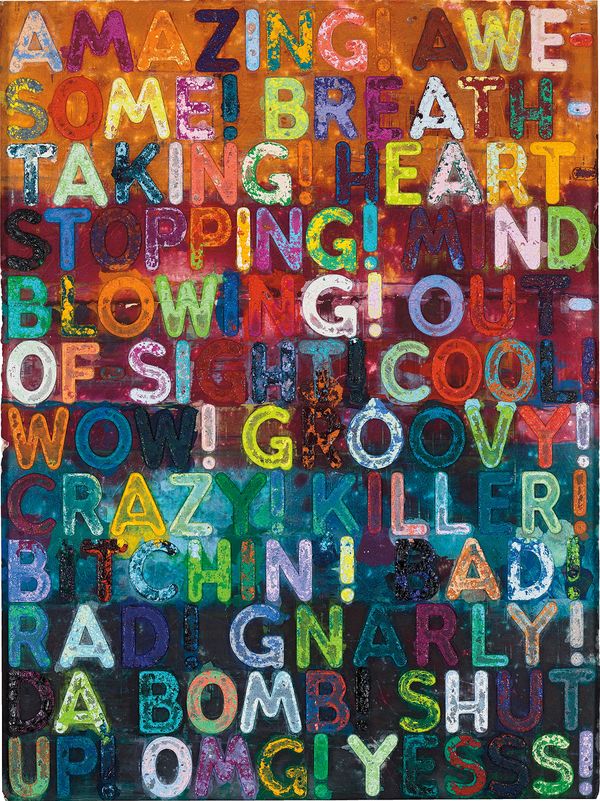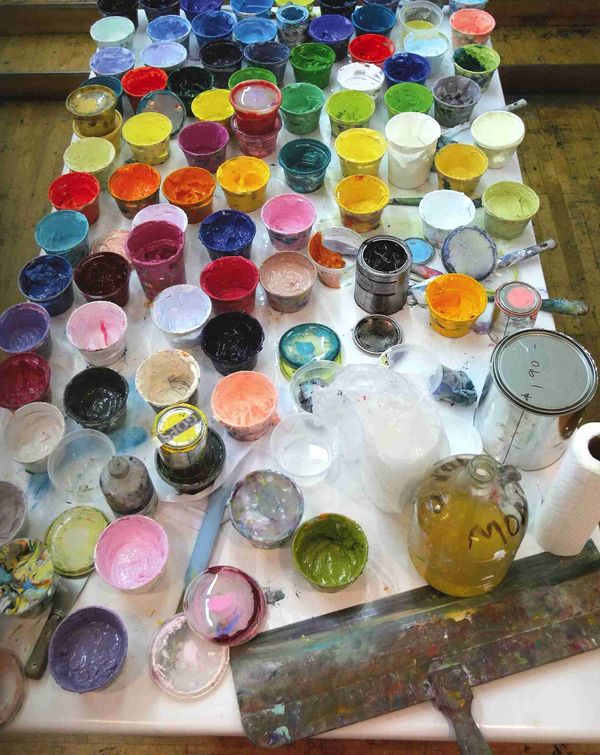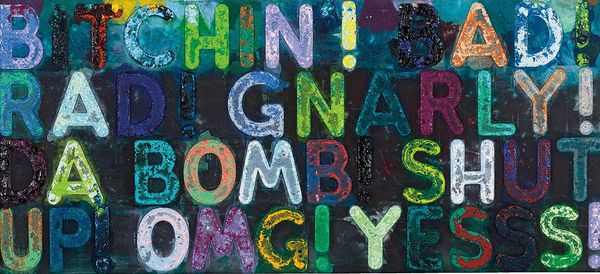Mel Bochner Amazing, 2018
The process is simple: create a matrix, apply ink, place paper, press. For printmakers around the world, the accuracy and precision in repeating this process create a reliable, predictable result. For Mel Bochner, working in collaboration with David Lasry at Two Palms Press, manipulation and experimentation in the exercise has created a new print methodology where these precision-driven techniques (every printmaker's bedrock) produce unexpected visual outcomes. The result is Bochner’s diverse range of monoprints, each a unique impression, no two the same.
Bochner’s monoprints have immense visual variety. Works can be predominantly monochromatic, others have subtle color variations, some can range from one extreme hue to the opposite, and letterforms can be closely related or starkly different to their ground colors. Prints vary in size and composition: single sheets, diptychs and the largest to date comprised of six sheets. The list of variables can be manipulated endlessly, allowing every result to be different.
The matrix used for Mel Bochner's Amazing, 2018
As with most printmaking methods, in each series of monoprints a single matrix is created and used repeatedly. The image is devised and the design laser-cut from a double-thick sheet of acrylic plastic. The cut-outs are then filled with oil paint and the plate placed on a hydraulic printing bed. A sheet of handmade paper is placed on top of the plate and 750 tons of pressure applied. The paper is pushed into the matrix and molded, adhering to the oil paint. When released, the resulting image is a complexity of layers and colors with perceptual and tangible depth. Seemingly, the steps and materials are overall traditional and expected, but the process depends upon chance for the specifics and it is these that characterize the final image.
Oil paints from Mel Bochner's studio
Through the development of this process, Bochner has tested the variables available to him. Early on, printing with ink was quickly replaced with oil paints, each altered with a mixture of linseed oil, stand oil, and damar varnish. Differing pigments call for variations in the formula, all of which have been perfected through trial and error. Most importantly, the viscosity of paints must be perfected to ensure each pigment releases itself from the matrix after being pressed. The application of paint alters with each use of the matrix and each trial takes days of paint mixing time. In an effort to suppress his color biases, Bochner occasionally requests printers to select color placement, ensuring the possibilities of the print are not limited. While colors can be chosen in a formulaic manner, their interaction within the mold and with the paper is up to chance. So in some ways, the application of paint is beyond the control of the artist, producing the unpredictable result.
The papers, made at Twinrocker Handmade Paper in Indiana, are composed of lightly beaten fibers suspended in water, then poured into molds where the water is drained. Each sheet is air-dried to allow maximum softness, enabling its effective full embossment in the printing process. Before printing the papers are refashioned, sheets are bonded to each other and then to watercolor paper for strength. Dyeing is done with alcohol-based pigments that don’t disintegrate the paper. Once dyed, sheets are stacked, allowing the wet color to migrate from one to another and, in some instances, papers are further hand-painted with watercolor. With the circumstantial nature of this process, only a limited amount of control is possible. For more recent prints the top layer of paper is constructed as a collage of dyed and painted fragments, both enlarging the sheet and creating variations to its thickness. This not only creates new possibilities for colors but affects the pressure variations when printing, impacting letterforms in the final image. To create larger prints, that exceed the regular limitations of the press bed, matrices are sometimes passed through the press three times, and some areas printed twice. Oil seepage created under printing pressure can transform the paper colors beneath, adding further incalculable variations to each print.
Detail from Mel Bochner's Amazing, 2018
The steps are simple and yet the specifics create a surprise. No better example portrays this than Amazing (lot 53), one of the most vibrant impressions of this matrix. One can imagine the printer and artist exclaiming ‘AMAZING!’ and ‘OMG YESSS!’ when seeing each finished product for the first time.



